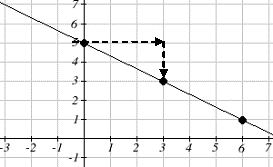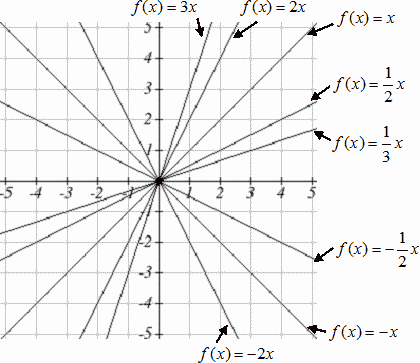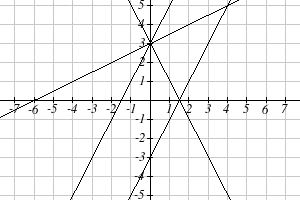Chapter 1: Algebra Review
Section 1.3 Linear Functions
Learning Objectives
By the end of this section, the student should be able to:
- Graph equations of the types [latex]y= f(x)=b+mx[/latex], [latex]y= c[/latex] and [latex]x=a[/latex].
- Graph linear functions.
- Find an equation of a line when given its slope and one point on the line and when given two points on the line.
- Solve applied problems involving slope and linear functions.
As you hop into a taxicab in Allentown, the meter will immediately read [latex]\$3.30[/latex]; this is the “drop” charge made when the taximeter is activated. After that initial fee, the taximeter will add [latex]\$2.40[/latex] for each mile the taxi drives. In this scenario, the total taxi fare depends upon the number of miles ridden in the taxi, and we can ask whether it is possible to model this type of scenario with a function. Using descriptive variables, we choose [latex]m[/latex] for miles and [latex]C[/latex] for Cost in dollars as a function of miles: [latex]C(m)[/latex].
We know for certain that [latex]C(0)=3.30[/latex], since the [latex]\$3.30[/latex] drop charge is assessed regardless of how many miles are driven. Since [latex]\$2.40[/latex] is added for each mile driven, we could write that if [latex]m[/latex] miles are driven, [latex]C(m)=3.30+2.40m[/latex] because we start with a [latex]\$3.30[/latex] drop fee and then for each mile increase, we add [latex]\$2.40[/latex].
It is good to verify that the units make sense in this equation. The [latex]\$3.30[/latex] drop charge is measured in dollars; the [latex]\$2.40[/latex] charge is measured in dollars per mile. So
[latex]C(m)=3.30\text{ dollars}+\left(2.40\frac{\text{dollars}}{\text{mile}}\right) (m\text{ miles}).[/latex]
When dollars per mile are multiplied by a number of miles, the result is a number of dollars, matching the units on the [latex]3.30[/latex], and matching the desired units for the [latex]C[/latex] function.
Notice that the equation [latex]C(m)=3.30+2.40m[/latex] consists of two quantities. The first is the fixed [latex]\$3.30[/latex] charge, which does not change based on the value of the input. The second is the [latex]\$2.40[/latex] dollars per mile value, which is a rate of change. In the equation, this rate of change is multiplied by the input value.
Looking at this same problem in table format, we can also see the cost changes by [latex]\$2.40[/latex] for every [latex]1[/latex] mile increase:
| [latex]m[/latex] | 0 | 1 | 2 | 3 |
| [latex]C(m)[/latex] | 3.30 | 5.70 | 8.10 | 10.50 |
It is important here to note that in this equation, the rate of change is constant; over any interval, the rate of change is the same.
Graphing this equation, [latex]C(m)=3.30+2.40m[/latex], we see the shape is a line, which is how these functions get their name: linear functions.

When the number of miles is zero, the cost is [latex]\$3.30[/latex], giving the point [latex](0, 3.30)[/latex] on the graph. This is the vertical, or [latex]C(m)[/latex], intercept. The graph is increasing in a straight line from left to right because for each mile, the cost goes up by [latex]\$2.40[/latex]; this rate remains consistent.
Linear Functions
Linear Function
A linear function is a function whose graph produces a line. Linear functions can always be written in the form [latex]f(x)=b+mx[/latex] or [latex]f(x)=mx+b,[/latex] where [latex]b[/latex] is the initial or starting value of the function (with input [latex]x = 0[/latex]), and [latex]m[/latex] is the constant rate of change of the function.
This form of a line is called slope-intercept form of a line.
Many people like to write linear functions in the form [latex]f(x)=b+mx[/latex] because it corresponds to the way we tend to speak: “The output starts at [latex]b[/latex] and increases at a rate of [latex]m[/latex].”
For this reason alone, we will use the [latex]f(x)=b+mx[/latex] form for many of the examples, but remember they are equivalent and can be written correctly both ways. (While this is the book’s convention, in class and in the videos I will likely use [latex]f(x)=mx+b[/latex].)
Slope and Increasing/Decreasing
[latex]m[/latex] is the constant rate of change of the function (also called slope). The slope determines if the function is an increasing function or a decreasing function.
- [latex]f(x)=b+mx[/latex] is an increasing function if [latex]m\gt 0[/latex].
- [latex]f(x)=b+mx[/latex] is a decreasing function if [latex]m\lt 0[/latex].
If [latex]m=0[/latex], the rate of change is 0, and the function [latex]f(x)=b+0x=b[/latex] is just a horizontal line passing through the point (0, b), neither increasing nor decreasing.
Video
Example 1
Marcus currently owns [latex]200[/latex] songs in his iTunes collection. Every month, he adds 15 new songs. Write a formula for the number of songs, [latex]N[/latex], in his iTunes collection as a function of the number of months, [latex]m[/latex]. How many songs will he own in a year?
The initial value for this function is [latex]200[/latex], since he currently owns [latex]200[/latex] songs, so [latex]N(0)=200[/latex]. The number of songs increases by [latex]15[/latex] songs per month, so the rate of change is[latex]15[/latex] songs per month. With this information, we can write the formula: [latex]N(m)=200+15m.[/latex]
[latex]N(m)[/latex] is an increasing linear function.
With this formula we can predict how many songs he will have in [latex]1[/latex] year ([latex]12[/latex] months): [latex]N(12)=200+15(12)=200+180=380.[/latex] Marcus will have [latex]380[/latex] songs in [latex]12[/latex] months.
Calculating Rate of Change
Slope/Rate of Change Formula
Given two values for the input, [latex]x_1[/latex] and [latex]x_2[/latex], and two corresponding values for the output, [latex]y_1[/latex] and [latex]y_2[/latex], or a set of points, [latex](x_1,y_1)[/latex] and [latex](x_2,y_2)[/latex], if we wish to find a linear function that contains both points, we can calculate the rate of change, [latex]m[/latex]:[latex]m=\dfrac{\text{change in output}}{\text{change in input}}=\dfrac{\Delta y}{\Delta x}=\dfrac{y_2-y_1}{x_2-x_1}.[/latex]
Rate of change of a linear function is also called the slope of the line.
Note in function notation, [latex]y_1=f(x_1)[/latex] and [latex]y_2=f(x_2)[/latex], so we could equivalently write [latex]m=\dfrac{f(x_2)-f(x_1)}{x_2-x_1}.[/latex]
Video
Example 2
The population of a city increased from 23,400 to 27,800 between 2002 and 2006. Find the rate of change of the population during this time span.
The rate of change will relate the change in population to the change in time. The population increased by 27800-23400=4400 people over the 4-year time interval. To find the rate of change, the number of people per year the population changed by [latex]\dfrac{4400 \text{ people}}{4\text{ years}}=1100\dfrac{\text{people}}{\text{year}}=1100 \text{ people per year}.[/latex]
Notice that we knew the population was increasing, so we would expect our value for [latex]m[/latex] to be positive. This is a quick way to check to see if your value is reasonable.
Example 3
The pressure, [latex]P[/latex], in pounds per square inch (PSI) on a diver depends upon their depth below the water surface, [latex]d[/latex], in feet, following the equation [latex]P(d)=14.696+0.434d[/latex]. Interpret the components of this function.
The rate of change, or slope, [latex]0.434[/latex] would have units [latex]\dfrac{\text{output}}{\text{input}}=\dfrac{\text{pressure}}{\text{depth}}=\dfrac{\text{PSI}}{\text{ft}}[/latex]. This tells us the pressure on the diver increases by [latex]0.434[/latex] PSI for each foot their depth increases.
The initial value, [latex]14.696[/latex], will have the same units as the output, so this tells us that at a depth of 0 feet, the pressure on the diver will be [latex]14.696[/latex] PSI.
We can now find the rate of change given two input-output pairs and could write an equation for a linear function if we had the rate of change and initial value. If we have two input-output pairs and they do not include the initial value of the function, then we will have to solve for it.
Example 4
Write an equation for the linear function graphed below.

Looking at the graph, we might notice that it passes through the points [latex](0, 7)[/latex] and [latex](4, 4).[/latex] From the first value, we know the initial value of the function is b = 7, so in this case, we will only need to calculate the rate of change: [latex]m=\dfrac{4-7}{4-0}=\dfrac{-3}{4}.[/latex]
This allows us to write the equation: [latex]f(x)=7-\frac{3}{4}x.[/latex]
Example 5
If [latex]f(x)[/latex] is a linear function, [latex]f(3)=-2[/latex], and [latex]f(8)=1[/latex], find an equation for the function.
The rate of change (or slope) of the function is [latex]m=\frac{1-(-2)}{8-3}=\frac{3}{5}[/latex]. In this case, we do not know the initial value [latex]f(0)[/latex], so we will have to solve for it. Using the rate of change, we know the equation will have the form [latex]f(x)=b+\frac{3}{5}x[/latex]. Since we know the value of the function when [latex]x = 3[/latex], we can evaluate the function at 3: [latex]f(x)=b+\frac{3}{5}(3)[/latex]. Since we know that [latex]f(3)=-2[/latex], we can substitute on the left side: [latex]-2=b+\frac{3}{5}(3)[/latex]. This leaves us with an equation we can solve for the initial value: [latex]b=-2-\frac{9}{5}=-\frac{19}{5}[/latex].
Combining this with the value for the rate of change, we can now write a formula for this function: [latex]f(x)=-\frac{19}{5}+\frac{3}{5}x.[/latex]
As an alternative to the approach used above to find the initial value, b, we can use the point-slope form of a line instead.
Point-Slope Equation of a Line
Point-Slope Formula
An equation for the line passing through the point [latex](x_1, y_1)[/latex] with slope m can be written as [latex]y-y_1=m(x-x_1).[/latex]
This is called the point-slope form of a line. It is a little easier to write if you know a point and the slope but requires a bit of work to rewrite into slope-intercept form and requires memorizing another formula.
Video
Example 6
Working as an insurance salesperson, Ilya earns a base salary and a commission on each new policy, so Ilya’s weekly income, [latex]I[/latex], depends on the number of new policies, n, he sells during the week. Last week he sold [latex]3[/latex] new policies and earned [latex]\$760[/latex] for the week. The week before, he sold [latex]5[/latex] new policies and earned [latex]\$920[/latex]. Find an equation for [latex]I(n)[/latex] and interpret the meaning of the components of the equation.
The given information gives us two input-output pairs: [latex](3,760)[/latex] and [latex](5,920)[/latex]. We start by finding the rate of change: [latex]m=\dfrac{920-760}{5-3}=\dfrac{160}{2}=80.[/latex]
Keeping track of units can help us interpret this quantity. Income increased by [latex]\$160[/latex] when the number of policies increased by [latex]2[/latex], so the rate of change is [latex]\$80[/latex] per policy; Ilya earns a commission of [latex]\$80[/latex] for each policy sold during the week.
We can now write the equation using the point-slope form of the line, using the slope we just found and the point [latex](3,760):[/latex] [latex]I-760= 80(n-3).[/latex]
If we wanted this in function form (slope intercept form), we could rewrite the equation into that form:
[latex]\begin{align*} I-760=& 80(n-3)\\ I-760=& 80n-240\\ I(n)=& 520+80n \end{align*}[/latex]
This form allows us to see the starting value for the function: [latex]520[/latex]. This is Ilya’s income when [latex]n = 0[/latex], which means no new policies are sold. We can interpret this as Ilya’s base salary for the week, which does not depend upon the number of policies sold.
Our final interpretation is: Ilya’s base salary is [latex]\$520[/latex] per week, and he earns an additional [latex]\$80[/latex] commission for each policy sold each week.
Graphs of Linear Functions
Graphical Interpretation of a Linear Equation
Graphically, in the equation [latex]f(x)=b+mx[/latex],
- [latex]b[/latex] is the vertical intercept of the graph and tells us we can start our graph at [latex](0, b)[/latex],
- and [latex]m[/latex] is the slope of the line and tells us how far to rise and run to get to the next point.
Once we have at least 2 points, we can extend the graph of the line to the left and right.
Example 7
Graph [latex]f(x)=5-\frac{2}{3}x[/latex] using the vertical intercept and slope.
The vertical intercept of the function is [latex](0, 5)[/latex], giving us a point on the graph of the line. The slope is [latex]-\frac{2}{3}[/latex]. This tells us that for every [latex]3[/latex] units the graph “runs” in the horizontal, the vertical “rise” decreases by [latex]2[/latex] units. In graphing, we can use this by first plotting our vertical intercept on the graph, then using the slope to find a second point. From the initial value [latex](0, 5)[/latex] the slope tells us that if we move to the right [latex]3[/latex], we will move down [latex]2[/latex], moving us to the point [latex](3, 3)[/latex]. We can continue this again to find a third point at [latex](6, 1)[/latex]. Finally, extend the line to the left and right, containing these points.

Another option for graphing is to use transformations of the identity function [latex]f(x)=x[/latex]. In the equation [latex]f(x)=mx[/latex], the [latex]m[/latex] is acting as the vertical stretch of the identity function. When [latex]m[/latex] is negative, there is also a vertical reflection of the graph. Looking at some examples will also help show the effect of slope on the shape of the graph:

In [latex]f(x)=mx+b[/latex], the [latex]b[/latex] acts as the vertical shift, moving the graph up and down without affecting the slope of the line. Some examples:

Try it for yourself using this applet:
Example 8
Match each equation with one of the lines in the graph below:
[latex]\begin{align*} f(x)=& 2x+3\\ g(x)=& 2x-3\\ h(x)=& -2x+3\\ j(x)=& \frac{1}{2}x+3 \end{align*}[/latex]

Only one graph has a vertical intercept of [latex]-3[/latex], so we can immediately match that graph with [latex]g(x)[/latex]. For the three graphs with a vertical intercept at [latex]3[/latex], only one has a negative slope, so we can match that line with [latex]h(x)[/latex]. Of the other two, the steeper line would have a larger slope, so we can match that graph with equation [latex]f(x)[/latex] and the flatter line with the equation [latex]j(x)[/latex].

In addition to understanding the basic behavior of a linear function (increasing or decreasing, recognizing the slope and vertical intercept), it is often helpful to know the horizontal intercept of the function – where it crosses the horizontal axis.
Finding Horizontal Intercept
The horizontal intercept of the function is where the graph crosses the horizontal axis. If a function has a horizontal intercept, you can always find it by solving [latex]f(x)=0[/latex].
Example 9
Find the horizontal intercept of [latex]f(x)=-3+\frac{1}{2}x[/latex].
Setting the function equal to zero to find what input will put us on the horizontal axis:
[latex]\begin{align*} 0=& -3+\frac{1}{2}x\\ 3=& \frac{1}{2}x\\ x=& 6 \end{align*}[/latex]
Thus the graph crosses the horizontal axis at [latex](6, 0)[/latex].
Intersections of Lines
The graphs of two lines will intersect if they are not parallel. They will intersect at the point that satisfies both equations. To find this point when the equations are given as functions, we can solve for an input value so that [latex]f(x)=g(x)[/latex]. In other words, we can set the formulas for the lines equal and solve for the input that satisfies the equation.
Economics tells us that in a free market, the price for an item is related to the quantity that producers will supply and the quantity that consumers will demand. Increases in prices will decrease demand, while supply tends to increase with prices. Sometimes supply and demand are modeled with linear functions.
Example 10
The supply, in thousands of items, for custom phone cases can be modeled by the equation [latex]s(p)=0.5+1.2p[/latex], while the demand can be modeled by [latex]d(p)=8.7-0.7p[/latex], where [latex]p[/latex] is in dollars. Find the equilibrium price and quantity, the intersection of the supply and demand curves.
Setting [latex]s(p)=d(p)[/latex], we find
[latex]\begin{align*} 0.5+1.2p=& 8.7-0.7p\\ 1.9p=& 8.2\\ p\approx& \$4.32 \end{align*}[/latex]
We can find the output value of the intersection point by evaluating either function at this input: [latex]s(4.32)=0.5+1.2(4.32)\approx 5.68.[/latex]
These lines intersect at the point (4.32, 5.68). Looking at the graph, this result seems reasonable.

Vocabulary
Media Attributions
- image047
- image048
- image049-1
- image050-1
- image051-1
- image052-1
- image095
- image053
a function with a constant rate of change that is a polynomial of degree 1, and whose graph is a straight line
the equation for a line that represents a linear function in the form f(x)=mx+b
change in the vertical coordinates (rise) to the change in the horizontal coordinates (run) between two points on a line. m = difference in y coordinates divided by the difference in x coordinates.
the equation for a line that represents a linear function of the form y − y(sub)1 = m(x − x(sub)1)
Vertical intercept (y-intercept) of a line: The point where a line intersects the vertical axis (y-axis) on a graph.
Horizontal intercepts, also known as x-intercepts, refer to the points where a graph intersects the x-axis. These points have a y-coordinate of zero and can be found by setting y equal to zero and solving for x. In other words, they are the points on a graph where the function value is zero.
a line defined by f(x)=b, where b is a real number. The slope of a horizontal line is 0.
Horizontal intercept (x-intercept) of a line: The point where the line intersects the horizontal axis (x-axis) on a graph.
two or more lines with the same slope
two lines that intersect at right angles and have slopes that are negative reciprocals of each other
a line defined by x=a , where a is a real number. The slope of a vertical line is undefined.

